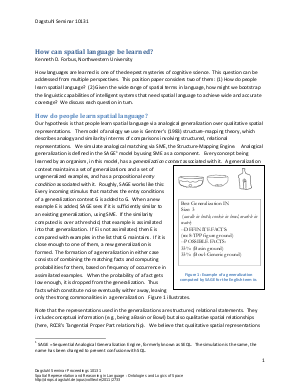How can spatial language be learned?
Author Kenneth D. Forbus
-
Part of:
Volume:
Dagstuhl Seminar Proceedings, Volume 10131
Part of: Series: Dagstuhl Seminar Proceedings (DagSemProc) - License:
 Creative Commons Attribution 4.0 International license
Creative Commons Attribution 4.0 International license
- Publication Date: 2011-01-04
File

PDF
DagSemProc.10131.2.pdf
- Filesize: 215 kB
- 3 pages
Document Identifiers
Subject Classification
Keywords
- Sketch understanding
- analogy
- spatial language
- spatial reasoning
Metrics
- Access Statistics
-
Total Accesses (updated on a weekly basis)
0PDF Downloads0Metadata Views
Abstract
How languages are learned is one of the deepest mysteries of cognitive science. This question can be addressed from multiple perspectives. This position paper considers two of them: (1) How do people learn spatial language? (2) Given the wide range of spatial terms in language, how might we bootstrap the linguistic capabilities of intelligent systems that need spatial language to achieve wide and accurate coverage? We discuss each question in turn.
Cite As Get BibTex
Kenneth D. Forbus. How can spatial language be learned?. In Spatial Representation and Reasoning in Language : Ontologies and Logics of Space. Dagstuhl Seminar Proceedings, Volume 10131, pp. 1-3, Schloss Dagstuhl – Leibniz-Zentrum für Informatik (2011)
https://doi.org/10.4230/DagSemProc.10131.2
BibTex
@InProceedings{forbus:DagSemProc.10131.2,
author = {Forbus, Kenneth D.},
title = {{How can spatial language be learned?}},
booktitle = {Spatial Representation and Reasoning in Language : Ontologies and Logics of Space},
pages = {1--3},
series = {Dagstuhl Seminar Proceedings (DagSemProc)},
ISSN = {1862-4405},
year = {2011},
volume = {10131},
editor = {John A. Bateman and Anthony G. Cohn and James Pustejovsky},
publisher = {Schloss Dagstuhl -- Leibniz-Zentrum f{\"u}r Informatik},
address = {Dagstuhl, Germany},
URL = {https://drops.dagstuhl.de/entities/document/10.4230/DagSemProc.10131.2},
URN = {urn:nbn:de:0030-drops-27336},
doi = {10.4230/DagSemProc.10131.2},
annote = {Keywords: Sketch understanding, analogy, spatial language, spatial reasoning}
}
